JEE Main Important Physics formulas
ApplyAs per latest 2024 syllabus. Physics formulas, equations, & laws of class 11 & 12th chapters
NCERT Solutions for Class 6 Maths Chapter 7 Fractions are discussed here. Our Expert team designed these NCERT solutions kepping in mind lated syllabus of CBSE 2023. A fraction is a number representing part of a whole. The whole may be a single object or a group of the object and the parts have to be equal. In Class 4 and 5 NCERT, you have already learnt about the representation of fractions. In Fraction class 6, you will learn about the various operations and applications of fractions in mathematics. You can also refer to the NCERT Books for Class 6 Maths to solve the problems covered under NCERT solutions for Class 6.
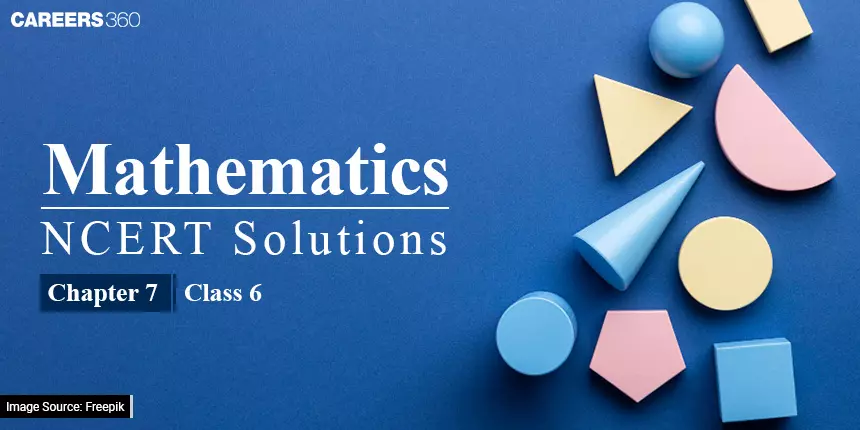
The subtopics covered under the NCERT Fraction class 6 are the representation of fractions on the number line, proper- improper and mixed fractions, the simplest form of the fractions, equivalent fractions, comparing fractions, comparing, unlike fractions, comparing like fractions, subtraction, and addition of fractions and adding or subtracting fractions. CBSE NCERT solutions for Class 6 Maths chapter 7 Fractions is covering the problems from each subtopic. In this chapter of NCERT Syllabus for Class 6 Maths, there are a total of 37 questions in 6 exercises. To help students in their preparation, we have designed NCERT solutions for class 6th math chapter 7. NCERT Solutions are also available class-wise and subject-wise.
A fraction can be represented as A/B, where A is called the numerator and B is called the denominator. The denominator cannot be zero.
Mixed fraction =Quotient {Remainder/Divisor)
Addition and subtraction of fraction with same denominator
A/B + C/B = (A+C)/B
A/B - C/B = (A-C)/B
Addition and subtraction of fraction with different denominator
A/B + C/D = AD/BD + BC/BD = (AD + CB)/BD
A/B - C/D = AD/BD - BC/BD = (AD - CB)/BD
Multiplication: Multiply numerator to numerator and denominator to denominator
(A/B)(C/D) = AC/BD
Division: Flip the second fraction and then multiply with the first fraction.
(A/B) /(C/D) = (A/B)(D/C) = AD/BC
Fraction: A fraction represents a part of a whole or a part of a group. It is expressed as a/b, where 'a' is called the numerator and 'b' is called the denominator.
Types of Fractions: Fractions can be classified as proper fractions, improper fractions, and mixed fractions. In a proper fraction, the numerator is smaller than the denominator. In an improper fraction, the numerator is equal to or greater than the denominator. A mixed fraction is a combination of a whole number and a proper fraction.
Equivalent Fractions: Fractions that represent the same value are called equivalent fractions. They have different numerators and denominators but represent the same part of a whole.
Simplification of Fractions: Fractions can be simplified by dividing both the numerator and the denominator by their common factors. The simplified fraction is the one in which the numerator and the denominator have no common factors other than 1.
Comparing Fractions: Fractions can be compared by cross-multiplication. If the product of the numerator of one fraction and the denominator of the other fraction is greater, then the first fraction is larger. If the product is smaller, then the second fraction is larger.
Addition and Subtraction of Fractions: For adding or subtracting fractions, the denominators must be the same. If they are different, the fractions need to be converted to equivalent fractions with the same denominator before performing the operation.
Multiplication of Fractions: To multiply fractions, multiply the numerators and multiply the denominators. The product is the numerator of the resulting fraction, and the product is the denominator.
Division of Fractions: To divide fractions, multiply the first fraction by the reciprocal (flipped version) of the second fraction. In other words, multiply by the numerator of the second fraction and divide by the denominator of the second fraction.
Representation of Fractions on a Number Line: Fractions can be represented on a number line by dividing the line segment between 0 and 1 into equal parts based on the denominator of the fraction.
Operations on Fractions and Whole Numbers: To perform operations involving fractions and whole numbers, convert the whole number into a fraction by giving it a denominator of 1, and then proceed with the operation
Free download NCERT Solutions for Class 6 Maths Chapter 7 Fractions PDF for CBSE Exam.
NCERT Solutions for Class 6 Maths Chapter 7 Fractions Exercise: 7.1
Q1 Write the fraction representing the shaded portion.
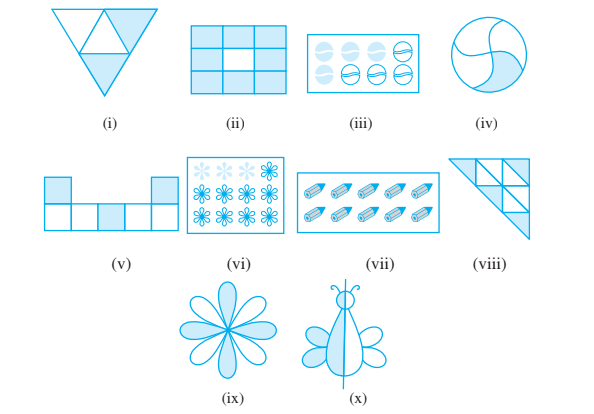
Answer: (i)
(ii)
(iii)
(iv)
(v)
(vi)
(vii)
(viii)
(ix)
(x)
 This is
This is
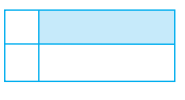 This is
This is
 This is
This is
Answer: Yes, the above fractions are wrong. For these fractions to be correct areas of each part should be same. But clearly, in the given figure, the areas are not the same.
Q5 What fraction of an hour is minutes?
Answer: We know that 1 hour has 60 minutes.
Thus fraction of 40 minutes is :-
Answer: Arya needs to divide one sandwich into 3 equal parts (as three persons are there.)
Thus each sandwich is divided into 3 parts.
Answer: Since they have to distribute 1 part in 3 people, hence the fraction received by each boy will be:-
Answer: The required fraction is:-
Q8 Write the natural numbers from to
What fraction of them are prime numbers?
Answer: We have :- 2, 3, 4, 5, 6, 7, 8, 9, 10, 11, 12.
Prime number :- 2, 3, 5, 7, 11.
Thus the fraction of prime numbers is:-
Q9 Write the natural numbers from to
. What fraction of them are prime numbers?
Answer: The natural numbers are :- 102, 103, 104, 105, 106, 107, 108, 109, 110, 111, 112, 113.
Prime numbers are :- 103, 107, 109, 113.
Thus fraction is :-
Q10 What fraction of these circles have ’s in them?

Answer: The number of boxes with X in them = 4
Total number of boxes = 8.
The required fraction is :
Q11 Kristin received a CD player for her birthday. She bought 3
CDs and received 5 others as gifts. What fraction of her total
CDs did she buy and what fraction did she receive as gifts?
Answer: The fraction of the CDs she bought is :
And the fraction of CDs received as gifts is :
Answer: First we write as
and divide the number line into 5 equal parts.

Answer:
First, we write as
and divide the number line in 10 equal parts.

Q3 Can you show any other fraction between and
?Write five more fractions that you can show.
Answer:
Yes. There are infinite number of fraction between and
(Numerator is less than denominator)
Five more fractions are:
Q4 How many fractions lie between and
? Think, discuss and write your answer?
Answer: There are infinite number of fractions between and
.
A fraction is of form and for a number lying between
and
, the numerator has to be less than the denominator.
Q1 Give a proper fraction : (a) whose numerator is and the denominator is
(b) whose denominator is and the numerator is
(c) whose numerator and denominator add up to . How many fractions of this kind can you make?
(d) whose denominator is more than the numerator.
(Give any five. How many more can you make?)
Answer: A proper fraction whose:
(a) the numerator is and the denominator is
=
(b) denominator is and numerator is
=
(c) numerator and denominator add up to .
Pairs of numbers having sum 10 =
Therefore, the proper fractions are
(d) denominator is more than the numerator. =
Q2 A fraction is given. How will you decide, by just looking at it, whether, the fraction is
(a) less than ?
(b) equal to ?
Answer: (a) If the numerator is smaller than the denominator, then the fraction will be less than .
(b) If the numerator is equal to the denominator, then the fraction will be equal to .
Q1 (a) Draw number lines and locate the points on them :
Answer: The number line is given below:-
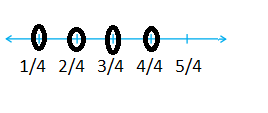
Q1 (b) Draw number lines and locate the points on them :
Answer: The number line is shown below with the required points marked.
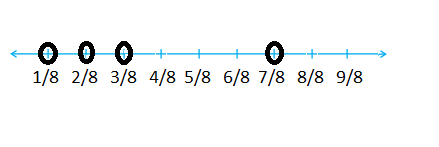
Q1 (c) Draw number lines and locate the points on them :
Answer: The number line locating the given fraction is shown below:-

Q2 Express the following as mixed fractions :
(a)
(b)
(c)
(d)
(e)
(f)
Answer: (a)
(b)
(c)
(d)
(e)
(f)
Q3 Express the following as improper fractions :
(a)
(b)
(c)
(d)
(e)
(f)
Answer: The improper fractions of the mixed fractions are given below :-
(a)
(b)
(c)
(d)
(e)
(f)
Q1 Write the simplest form of :
(i)
(ii)
(iii)
(iv)
(v)
Answer: (i)
(ii)
(iii)
(iv)
(v)
Answer: Yes, is in its simplest form because 49 and 64 has no common divisor.
Q1 Are and
;
and
;
and
and equivalent? Give reason
Answer: and
;
and
are not equivalent because
and
but
Q3 Identify the fractions in each. Are these fractions equivalent?
Answer:
(i) (ii)
(iii)
(iv)
all fractions in it simplest form is
So all fractions are equivalent
Q1 Find five equivalent fractions of each of the following:
(i)
(ii)
(iii)
(iv)
Answer: (i)
(ii)
(iii)
(iv)
Q1 Write the fractions. Are all these fractions equivalent?


Answer: In the case of (a), we have:-
(i)
(ii)
(iii)
(iv)
Hence all fractions are equal in this case.
In the case of (b), we have:-
(i)
(ii)
(iii)
(iv)
(v)
Q2 Write the fractions and pair up the equivalent fractions from each row.
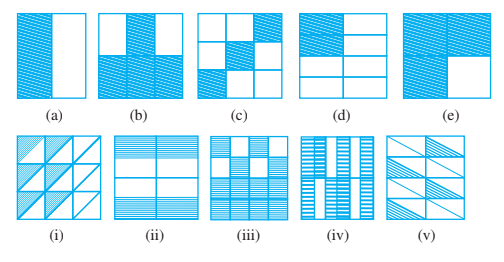
Answer: The fractions of each are given below :-
(a)
(b)
(c)
(d)
(e)
Similarly,
(i)
(ii)
(iii)
(iv)
(v)
Q3 (a) Replace box in each of the following by the correct number :
Answer: The correct number is 28.
Thus .
Q3 (b) Replace in each of the following by the correct number :
Answer: (b) The correct answer is 16.
Q3 (e) Replace in each of the following by the correct number :
Answer: The correct number is .
Multiplying numerator and denomenator by .
We have :-
Hence
Q4 Find the equivalent fraction of having
(a) denominator
(b) numerator
(c) denominator
(d) numerator
Answer: (a) Multiply numerator and denominator by 4, we have :
(b) Multiply numerator and denominator by 3, we have :
(c) Multiply numerator and denominator by 6, we have :
(d) Multiply numerator and denominator by 9, we have :
Q5 Find the equivalent fraction of with
(a) numerator
(b) denominator
Answer: The required equivalent fractions are given below :-
(a) Divide both numerator and denomenator by 4.
(b) Divide both numerator and denomenator by 12.
Q6 (a) Check whether the given fractions are equivalent :
Answer: Multiply both numerator and denominator by 6.
Q6 (b) Check whether the given fractions are equivalent :
Answer:
Multiply both numerator and denominator by 4, we get :
Q6 (c) Check whether the given fractions are equivalent :
Answer: Multiply both numerator and denominator by , we get :
Hence these two fractions are not the same.
Q7 Reduce the following fractions to simplest form :
(a)
(b)
(c)
(d)
(e)
Answer: (a)
(b)
(c)
(d)
(e)
Answer: The fraction of pencils used by Ramesh is:-
The fraction of pencils used by Sheelu is:-
The fraction of pencils used by Jamaal is:-
Thus, the fractions of pencils used by each are the same.
Q9 Match the equivalent fractions and write two more for each.
(i) (a)
(ii) (b)
(iii) (c)
(iv) (d)
(v) (e)
Answer: (i)
(ii)
(iii)
(iv)
(v)
Answer: My sister gets more because
Q1 Which is the larger fraction?
(i) or
(ii) or
(iii) or
Answer: The fractions are shown below using greater than or less than sign
(i)
(ii)
(iii)
Q1 (1) Arrange the following in ascending and descending order :
Answer: (a)
and
Q1 (b) Arrange the following in ascending and descending order :
Answer: The following in ascending and descending order are :
(b)
Q1 (c) Arrange the following in ascending and descending order :
Write 3 more similar examples and arrange them in ascending and descending order.
Answer: The following in ascending and descending order are:
(i)
and
(ii)
and
(iii)
and

 (c) Show
(c) Show on the number line. Put appropriate signs between the fractions given
Answer: (a)
(b)
(c)

From the above number line we can compare the given numbers easily.
Q2 Compare the fractions and put an appropriate sign.
(a)
(b)
(c)
(d)
Answer: The comparison is given below :-
(a)
(b)
(c)
(d)
Q4 (a) Look at the figures and write between the given pairs of fractions.

(a)
Answer: With the help of given diagram :
Thus
Q4 (b) Look at the figures and write between the given pairs of fractions.
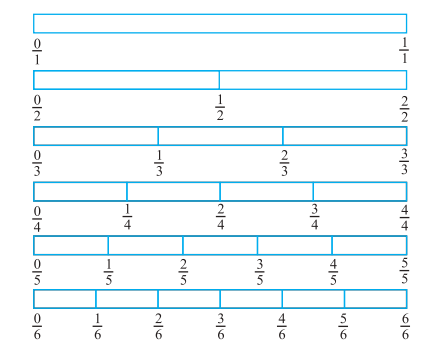
(b)
Answer: From the diagram it is cleat that :
Q4 (c) Look at the figures and write between the given pairs of fractions.

(c)
Answer: From the given diagram, we can clearly say that :-
Q4 (d) Look at the figures and write ‘<’ or ‘>’, ‘=’ between the given pairs of fractions.
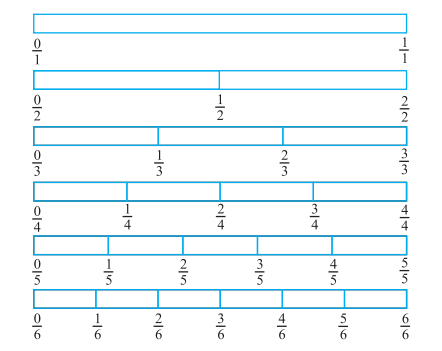
(d)
Answer: From the diagram it is clear that :-
Q5 How quickly can you do this? Fill appropriate sign.
(a)
(b)
(c)
(d)
(e)
(f)
(g)
(h)
(i)
(j)
(k)
Answer: (a)
(b)
(c)
(d)
(e)
(f)
(g)
(h)
(i)
(j)
(k)
(a)
(b)
(c)
(d)
(e)
(f)
(g)
(h)
(i)
( j)
(k)
(l)
Answer: (i)
(ii)
(iii)
(iv)
(v)
(vi)
(vii)
(viii)
(ix)
(x)
(xi)
(xii)
Q7 (a) Find answers to the following. Write and indicate how you solved them.
Is equal to
Answer: No.
Multiply numerator and denomenator by .
We have :
Hence
Q7 (b) Find answers to the following. Write and indicate how you solved them.
Is equal to
?
Answer: We have .
Q7 (c) Find answers to the following. Write and indicate how you solved them.
Is equal to
Answer: Yes.
By multiplying numerator and denominator by 5, we get :
Q7 (d) Find answers to the following. Write and indicate how you solved them.
Is equal to
?
Answer: No.
Multiply both numerator and denomenator by 2, we get :-
Q8 Ila read pages of a book containing
pages. Lalita read
of the same book. Who read less?
Answer: The fraction of the book read by Ila is:-
So we can compare the fraction now:-
Hence Ila reads less.
Answer: Who exercised for a longer time can be found by comparing the fraction of their work time.
Hence Rohit exercised for a longer time.
Answer: In class A, the fraction of students passed with or above marks :
And, in class B, the fraction is :
Hence the required fraction is same in both the classes.
Answer: mother gave to me part
mother gave to my brother part
She gave both off us
part
Answer: Neelu picked stones
brother picked up the stones
The total fraction of the stones they both pick up together
of total stones.
Answer: He put covers on Monday=
He put the cover on Tuesday =
and the remaining on Wednesday.
Thus, the fraction of the covers he put on Wednesday =
Q1 Find the difference between and
.
Answer: The difference between and
is given by
Answer: Seema ate =
I eat =
Total part eaten is
The left part would be
Answer: I ate=
My friend ate =
we both eat
the watermelon more I eat than my friend is
The portion of the watermelon remained
Q1 Write these fractions appropriately as additions or subtractions :




Answer: In case (a) - Addition
case (b) - Subtraction
case (c) - Addition
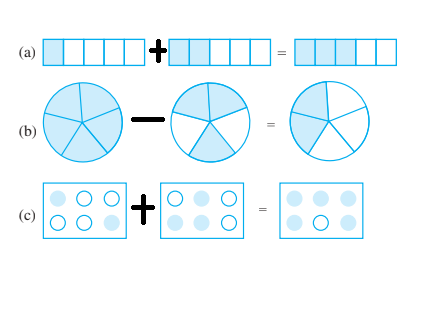
Answer: Total wall painted = Wall painted by Subham + Wall pained by Madhavi
Hence the whole wall is painted by them.
Q5 Javed was given of a basket of oranges. What fraction of oranges was left in the basket?
Answer: The total fraction of oranges in the basket are .
Thus the fraction of oranges left is :
Q1 Add and
.
Answer: Addition of and
is given by
Q1 Solve
(a) (b)
(c)
(d) (e)
(f)
Answer: (a)
(b)
(c)
(d)
(e)
(f)
Answer: The total length of ribbon is given :-
Thus total length of ribbon is .
Answer: Total amount of cake given to both = Cake given to Naina + Cake given to Najma
Answer: Let the length of another piece of wire be x.
Thus,
Hence the length of other part is .
Answer: The distance Nandini walked is given by :-
Hence she walked .
Answer: If we compare the bookshelves of both, we obtain that :
Also,
Hence the bookshelf of Asha is more full and by fraction.
Answer: Firstly, let us convert the time taken by Jaidev in the improper fraction from mixed fraction.
Now, comparing both, we have :
Also,
Hence Rahul takes less time as compared to Jaidev by a fraction.
NCERT Solutions for Class 6 Mathematics Chapter Wise
| Chapters No. | Chapters Name |
| Chapter - 1 | Knowing Our Numbers |
| Chapter - 2 | Whole Numbers |
| Chapter - 3 | Playing with Numbers |
| Chapter - 4 | Basic Geometrical Ideas |
| Chapter - 5 | Understanding Elementary Shapes |
| Chapter - 6 | Integers |
| Chapter - 7 | Fractions |
| Chapter - 8 | Decimals |
| Chapter - 9 | Data Handling |
| Chapter -10 | Mensuration |
| Chapter -11 | Algebra |
| Chapter -12 | Ratio and Proportion |
| Chapter -13 | Symmetry |
| Chapter -14 | Practical Geometry |
Extensive Topic Coverage: The solutions for maths class 6 chapter 7 encompass all the important topics and subtopics of the chapter, ensuring that students have a thorough understanding of the content.
Focus on Exam Readiness: The NCERT Class 6 Maths Chapter 7 solutions adopt an exam-focused approach, equipping students with the necessary skills and strategies to approach exam questions effectively and perform well.
Interactive Learning: The NCERT class 6 maths chapter 7 promote interactive learning by incorporating illustrations, diagrams, and practical examples, making the learning process engaging and enjoyable for students.
Step-by-Step Solutions: Each problem in the fraction questions for class 6 is accompanied by a detailed step-by-step solution, enabling students to follow the logical thought process and learn problem-solving techniques.
Keep learning and working hard!
Also Check NCERT Books and NCERT Syllabus here:
A fraction is a number representing part of a whole.
Example-1/2, 3/4...
Students we get detailed discussion about the concepts related to fraction above in this article.
In maths class 6 chapter 7 NCERT Solutions, you will learn about the following important topics:
A total of 6 exercise are discussed in the chapter 7 maths class 6. After practicing these exercises, Students get command on the concepts which ultimately lead to confidence during the exam and finaly able to score well in the exam.
Fractions, in Chapter 7 of Class 6 Maths NCERT Solutions, are defined as parts of a whole number. They are expressed as a ratio between two integers, one written above the other and separated by a line. The number above the line is called the numerator, and the number below the line is called the denominator.
Yes, you can download the NCERT Solutions for Class 6 Maths Chapter 7 in PDF format from Careers360. These solutions have been prepared by highly experienced faculty, following the latest CBSE board syllabus. You can use the PDF to cross-check your answers and understand different methods of solving complex problems with ease.

As per latest 2024 syllabus. Physics formulas, equations, & laws of class 11 & 12th chapters

Get up to 90% scholarship on NEET, JEE & Foundation courses

As per latest 2024 syllabus. Chemistry formulas, equations, & laws of class 11 & 12th chapters

Enrol in PACE IIT & Medical, Financial District, Hyd for JEE/NEET preparation

Start your JEE preparation with ALLEN

Ace your NEET preparation with ALLEN Online Programs